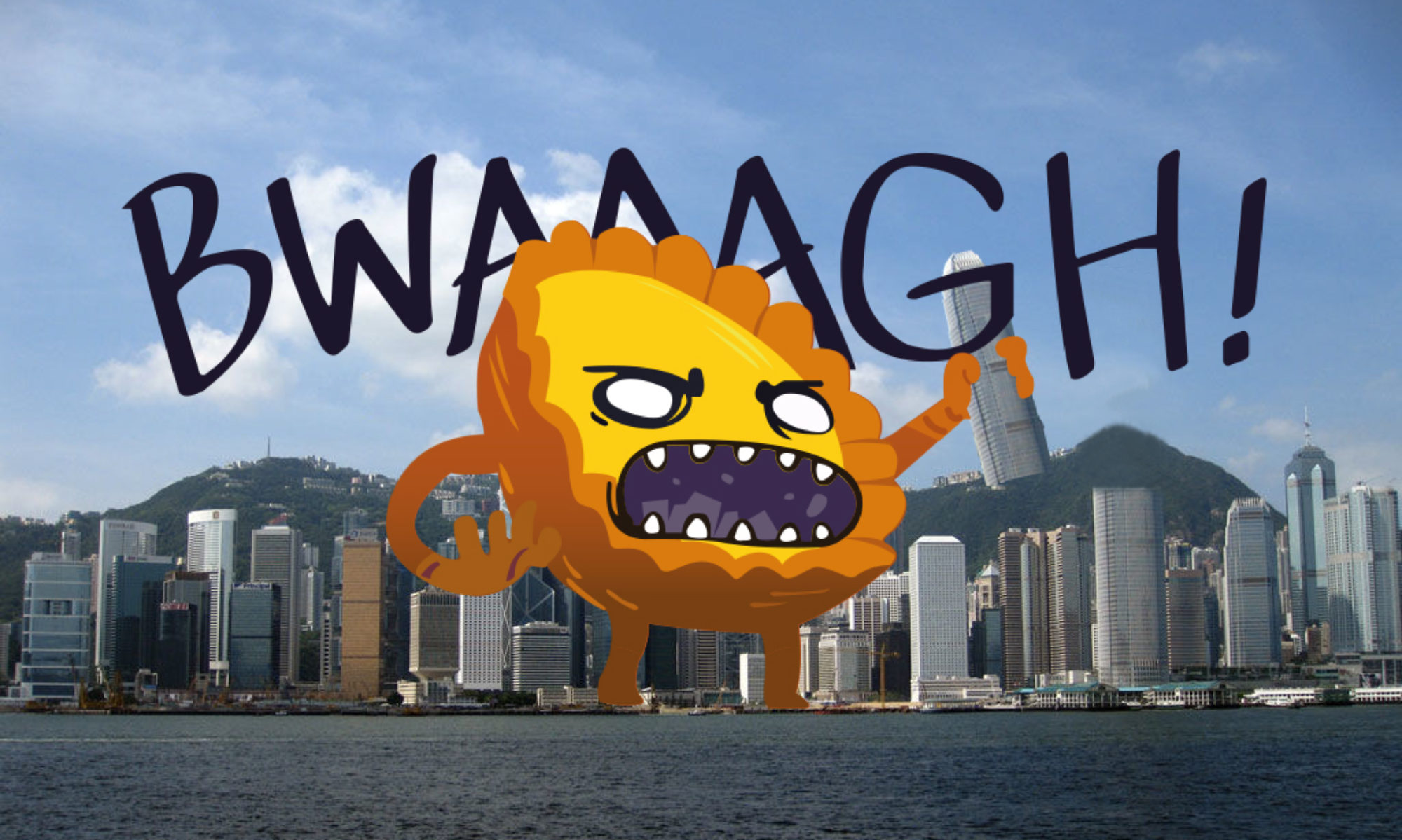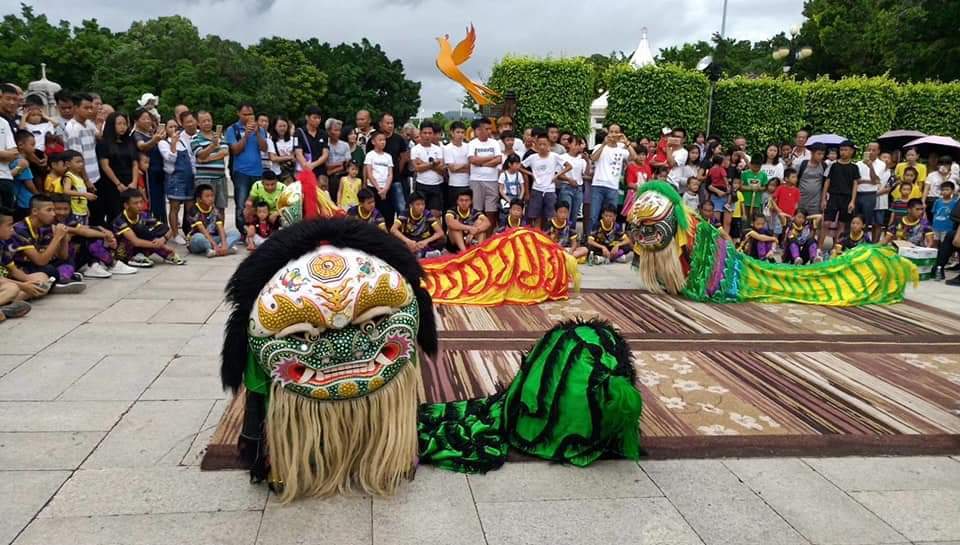Written by Billy Potts
This is the tenth in a series of articles in which we explore the imaginary creatures of Hong Kong, their makers and those that take part in their culture. The tenth cryptid in our fantastic menagerie is the much maligned Pei Yau, known for his rapacity and avarice. This article was first published in Zolima City Mag
As night descends on Tung Chung, a breeze whistles through the tenebrous playgrounds of HKFEW Wong Cho Bau Secondary School. Dark shapes hulk in pools of shadow. Among them is Chan Hon-kit, who roams the labyrinthine halls, explaining the story behind an unusual and elusive creature – the pei yau (pei4 jau1 貔貅).
Chan is tall, powerfully built and bespectacled, and he is a teacher with the Eagle Crane Martial Arts Association (ECMAA). As he enters a luminous dance hall, his waiting troupe jumps to attention. Chan has been training this team in Hakka martial arts for decades, and he often sees his teenaged apprentices through to adulthood, instilling the values of discipline and civic mindedness throughout their training. But he has another mission too. The ECMAA is one of only two or three associations in Hong Kong that are trying to revive the culture of the pei yau.
Pei yau are hybrid creatures. Descriptions of their morphology vary wildly. The ECMAA’s founder, Master Au Siu-wing, describes the pei yau as “a fierce animal that looks like a tiger and a bear with grey-white fur,” but they also appear as winged creatures with either single or double horned, leonine heads. One horn denotes a male pei yau and twin horns a female.

Hakka pei yau are most commonly seen in Hong Kong and appear as wild eyed monsters with simian faces and unruly black hair. In addition to the Hakka pei yau, there is a Hoi Luk Fung subspecies from Shanmei. This taxonomic branch features a bearded animal bearing the fanged countenance of a demon king. The character 王 (wong4, “king”) is emblazoned across its brow.
The one commonality between all these variants is the pei yau’s most striking feature – its lack of an anus. The anus was said to have been sealed from a spanking dealt by the Jade Emperor as punishment for defecating on heaven’s floor. This, combined with the pei yau’s diet of gold, silver and jewels, makes the constipated creature a symbol for the accumulation and preservation of wealth. Riches go in but never come out.
As a result, pei yau are popular in the murky world of casinos and mahjong dens, keeping watch over the punters and suppressing their luck in the house’s favour. Banks and other financial institutions also prize the pei yau’s rapaciousness. Seldom seen because of their tawdry associations, pei yau are celestial creatures nonetheless. Renowned for their ferocity and aggression, they once symbolised prestige and righteous martial power, often appearing on pennants and battle flags. In modern times, says Au, they are more closely associated with “rogues, scoundrels and mischievous troublemakers.”
In the dance hall, Chan’s apprentices have laid out two pei yau on the polished wooden floor. They are a strange sight to behold. Green noses, pointed ears and horns sprout from their crimson masque faces. Their jutting lower jaws reveal menacing teeth. These are feral beasts and few dare meet their murderous gaze. “For this reason,” says Au, “when a pei yau is at rest, its eyes are concealed with red paper.”
At their teacher’s bidding, the Eagle Crane group take up the pei yau and leap into an energetic dance accompanied by the clangor of drum, gong and cymbals. “This folk dance requires solid martial arts foundations,” Chan explains. “Without them it would be impossible.” Sam Tam, chairman of the Hong Kong Dragon Lion Unicorn Pei Yau Dances Sport Association, notes that the technical skill required for dancing the pei yau is extremely high. Derived from the martial arts traditions of dung1 gwong1 kyun4 (東光拳) and lung4 jing4 kyun4 (龍形拳), the movements involve very low stances, known as maa5 bou6 (馬步). But there is also the Hoi Luk Fung version of the pei yau dance, derived from the Fujian Southern Shaolin tradition, whose stances are slightly higher.


Pei yau are an endangered species. The 1990s saw a steep decline in their numbers and, today, pei yau dances tend to be performed mainly in Yuen Long by the Hakka or people with roots in Huizhou. According to Tam, there is very little information available about pei yau dances. “These days even the Hakka seem to prefer qilin dances,” he says.
“Lion, dragon and qilin dancing are much more common because these are benevolent creatures and there are many occasions where they are welcomed,” explains Tam. “There are very few appropriate occasions for pei yau to appear because their character is aggressive and fierce. People don’t want pei yau in their temples or places of worship. Their murderous demeanour” — a trait called saai3 hei3 (殺氣) — “is unsuitable. If I were to count the number of associations doing pei yau dancing I don’t know if I could even count ten. I really doubt if I could.”
Despite the odds, however, the pei yau’s fortunes are now improving. Chan’s troupe is genuinely attempting to revive the old Hakka tradition, but when there is profit to be made, pretenders will emerge. “Sometimes lion dancing associations try to do pei yau dances to turn a quick buck,” says master paper craftsman Andy Ho. “If anybody who knew their stuff was to watch them perform, they would know in an instant that these were posers. Pei yau dances are entirely different to those of lions and qilins. In this day and age there aren’t many people who can do it properly. It would look really bad.”
This admonition brings to mind the words of Peng Chau qilin maker, Ringo Leung: “To take part in pei yau culture you are declaring that you are the best and if you come up short, well…” he trails off ominously.
Andy Ho comes from a respected line of Hong Kong paper craftsmen. Operating out of his Tsuen Wan flat, the diminutive sifu collaborates with his mentor, Gum Wei, in creating distinctive lions trimmed with rabbit fur. With a career spanning 20 years, Ho’s creations are unique in his amalgamation of highly traditional styles and unorthodox modern influences. “I do lots of research into paper crafts from the ‘50s but I like taking cues from industrial arts and even anime,” Ho explains while swiping through an enormous and eclectic reference collection.


The best example of this unlikely style can be seen in the horns on Ho’s lions. The master enjoys the hyper traditional practice of rendering horns as eagles, dragon fish, and other animals but gives them a modern twist by favouring enormous manga-style eyes. The result is powerful and the sifu obviously enjoys his playful work; he often breaks out in paroxysms of impish tittering. It isn’t often that the sifu gets the opportunity to create a pei yau, but when one comes along, he takes it on with relish.
Hakka pei yau are roughly circular mask constructions measuring 18 inches across; they are relatively simple when compared to other creatures. Ho takes special care even with this basic form. “I do lots of research and look at old information before I dare to do these things,” he says. “You have to get the proportions right or else it just looks off. For instance amateurs don’t know any better so as they work with the pei yau’s face laid flat on a table, they make the eyes stare straight up at the ceiling. Tradition demands that pei yau eyes look slightly downwards. They look a bit gawky if they stare straight ahead”. After building a pei yau’s distinctive visage, Ho always imbues his creations with his signature flair, decorating them with painted dice and mahjong tiles to reinforce their prosperous symbolism.
A pei yau’s head is held in front of the dancer’s by means of two metal rods built into the mask’s inside. The dancer swings the creature’s head from side to side in rapid punching motions, flinging its long black mane in wild arcs. “Looks like a crazy woman,” Ho giggles. According to the sifu, this hair is made of the same material used for beards in Cantonese opera – “a type of bovine hair,” he says, swinging a sample over his head. “We use it because no matter how it is flung around the strands never tangle. Nylon should never be used. You need to order this specially.”

As the evening wears on, the Eagle Crane group perform one last routine. This dance depicts the story of a pei yau who has reformed from his bloodthirsty ways and become Buddha’s steed. His master has charged him with guarding a pouch. A green monkey and a “Big Head Buddha” (daai6 tau4 fat6 大頭佛) suddenly appear, making off with the pouch. The pei yau must recover the treasure without reverting to his violent nature; it is this inner turmoil which informs the dance’s energetic, jerky movements.
Despite his homicidal tendencies, avaricious reputation and comical handicap, the pei yau is perhaps the most relatable of Hong Kong’s imaginary creatures. It is easy to admire the dragon’s regal airs, the lion’s festive bonhomie and the qilin’s gentle grace, but the complex character of the pei yau is at least an honest representation of the flaws and inner conflict we all face and must overcome.

